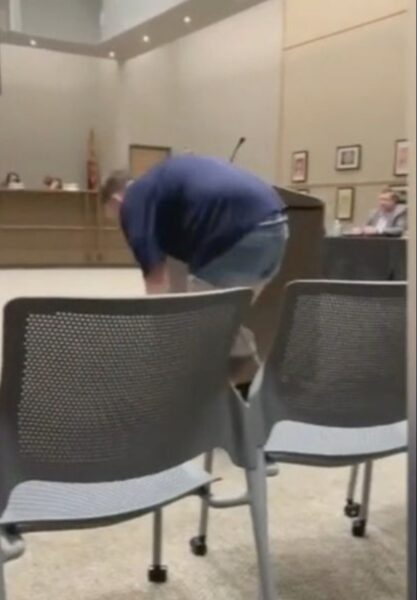Many parents have strong reactions when schools alter policies that directly affect their children. One father in Arizona was particularly incensed upon learning about a change to the school’s dress code requirements.
He took a dramatic approach to express his discontent.
Read on to discover what he did…

At a school board meeting in Gilbert, Arizona, an unexpected demonstration unfolded when a father named Ira Latham stripped down to a surprising ensemble. Underneath his professional attire, he revealed a crop top and short shorts, aiming to make a strong statement.
“Under the proposed policy, this attire would be considered appropriate for the classroom,” Ira Latham declared during the meeting. He removed his shirt and pants right at the podium to emphasize his point.
The meeting was convened to debate a more lenient dress code that Higley Unified School District had started discussing in May. The community had been actively following these discussions, anticipating changes to the policy.

The revised dress code policy states that “clothing must cover all private body parts and/or undergarments and must not be see-through. Incidental visibility of undergarment waistbands and/or straps under clothing is allowed; however, undergarments may not be worn as outerwear.”
In a striking demonstration, the father donned a crop top and short shorts to illustrate what the new policy would allow students to wear to school. He stated, “Under the proposed policy, this would be appropriate in a classroom.”
This new dress code represents a significant shift from the previous regulations established in 2001, now permitting students to show their chest, abdomen, and midriff.

Latham, a father of four children in the school district, argued that the new dress code would detract from his children’s educational experience. He expressed, “As a parent, I expect the district to enforce policies that support a safe classroom environment and minimize distractions,” he said.
“This policy fails to achieve that. It also puts undue pressure on teachers due to its ambiguity,” he added.
To underscore his concerns, Latham chose to wear an outfit permissible under the new regulations, stating, “To demonstrate my points about this policy, I’ll provide an object lesson,” before disrobing.
“Now, this outfit would be considered inappropriate for a board meeting. If our dress code allows this in the classroom, it’s not conducive to a safe learning environment,” Latham concluded, visibly frustrated.
However, Tiffany Schulz, the governing board president, disagreed with Latham’s critique, noting that the existing rules disproportionately affected female students.
On the other hand, board member Anna Van Hoek supported Latham’s stance, emphasizing the importance of a modest dress code in preparing students for professional environments. “A modest dress code equates to self-respect. If we’re preparing our children for college and careers, they need to learn that self-respect doesn’t involve exposing their bodies,” she argued.

Latham expressed his frustration to the media, likening the proposed dress code to that of a public pool: “The new policy basically reduces the dress code to just ensuring kids cover their underwear, and that’s about it.”
However, Tiffany Schulz, the governing board president, criticized this perspective, highlighting that the policy change primarily affects female students who commonly wear crop tops and tank tops. “We’re being told to make them cover up because of how it might make others feel, which is fundamentally wrong,” Schulz argued.
She also emphasized that teachers should focus on educating rather than policing student attire or making female students feel uncomfortable. Amanda Wade, another board member, echoed Schulz’s sentiment, noting, “These are children, not employees. While school is essentially their main job, we must allow them some freedom.”
Despite Latham’s vocal opposition, the school board ultimately approved the new dress code with a 3-2 vote.
While Higley Unified School District adopts a more relaxed dress code, other districts like Mississippi’s Madison, Rankin, and Hinds County are tightening restrictions. These districts have banned crop tops, mandated that shirts cover the stomach, insisted pants be free of holes, and set specific skirt lengths.
The story of Latham’s protest underscores the strong feelings parents can have about school policies affecting their children.
What are your thoughts on schools implementing dress codes? Share your views in the comments and see what others think as well!







